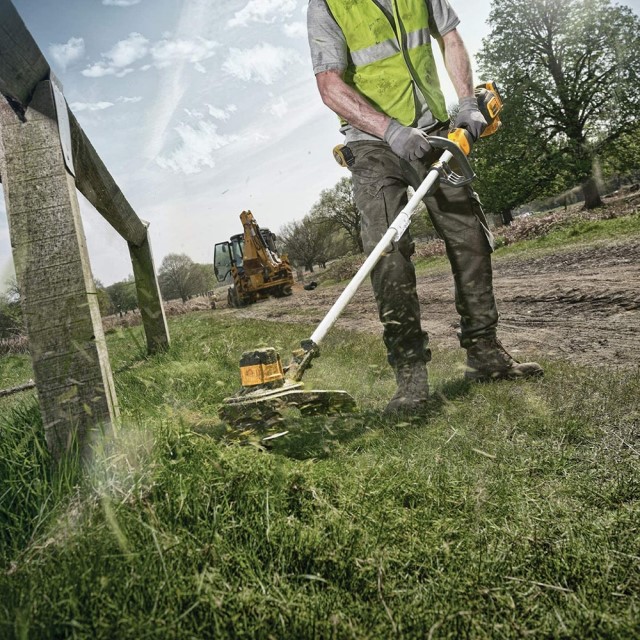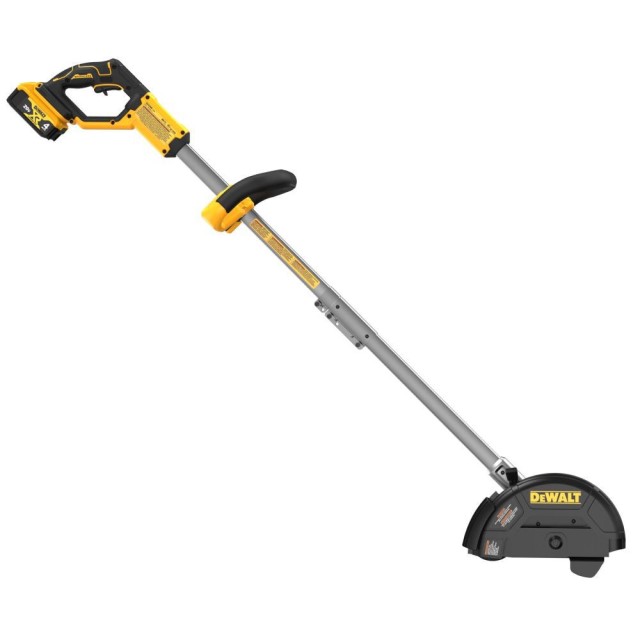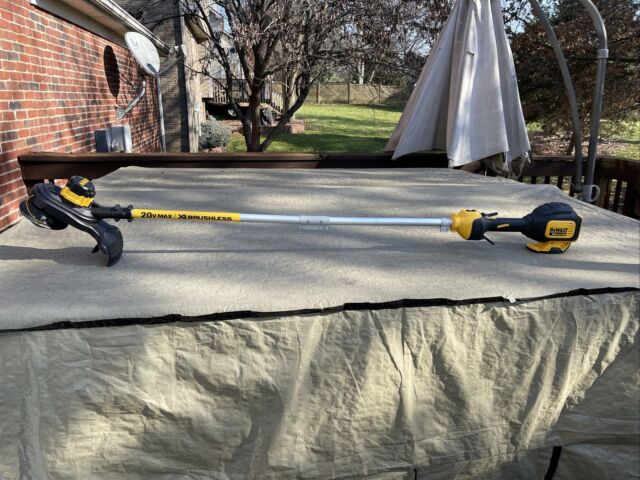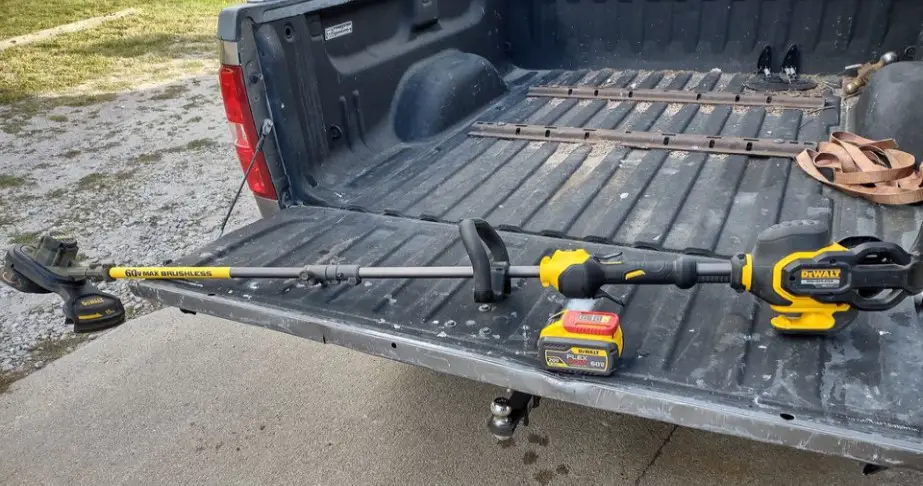Maintaining and restringing your DeWalt weed eater is essential for achieving optimal performance.
A well-maintained weed eater not only improves efficiency but also prolongs its lifespan.
Whether you’re a seasoned gardener or a weekend warrior tackling your yard chores, understanding the ins and outs of restringing your DeWalt weed eater is a valuable skill that will save you time, money, and frustration.
How to Restring a Dewalt Weed Eater
Step 1: Choose the Right Trimmer Line
It’s essential to consider the specific needs of your yard and the types of vegetation you typically encounter when choosing the right trimmer line.
Take into account the density, toughness, and thickness of the plants you’ll be trimming.
The trimmer line is the cutting mechanism of the weed eater, and its selection directly impacts the efficiency and effectiveness of the tool.
A thinner line may not have sufficient cutting power for thicker grass or brush, while a thicker line might be excessive for light trimming tasks.
You can make an informed decision that suits your specific needs by understanding the different types of trimmer lines available and their specific characteristics.
Related: Stinger Super Seeder Review
Nylon Trimmer Line
These are the most commonly used and versatile options.
They’re available in various thicknesses and are suitable for general trimming tasks. Thin nylon lines, such as 0.065 inches, are ideal for light grass and weeds.

They offer flexibility and are less likely to damage delicate vegetation or cause excessive vibrations.
Medium-thickness nylon lines, such as 0.080 inches, provide a balance between cutting power and durability, making them suitable for medium-density vegetation.
Twisted Trimmer Line
They’re constructed by twisting two or more strands of nylon together. This design enhances their cutting strength and durability.
Twisted lines are well-suited for trimming thicker grass, weeds, and small brush.
They’re less prone to breakage and can handle more demanding tasks compared to standard nylon lines.
If you have a yard with moderate to dense vegetation, a twisted trimmer line, typically ranging from 0.085 to 0.105 inches, would be a suitable choice.
Serrated Trimmer Line
For dense and tougher vegetation, such as heavy weeds, brush, or even small saplings, a serrated trimmer line is the preferred option.
Serrated lines have small teeth or edges along the surface, which provide enhanced cutting power.
These lines are more aggressive and can tackle challenging trimming tasks more effectively.
Serrated trimmer lines are generally thicker and sturdier, ranging from 0.095 to 0.155 inches, depending on the intensity of the job.
Step 2: Prepare for Restringing
Preparing for the restringing process is an important step to ensure both your safety and the smooth execution of the task.
By taking the following precautions and performing necessary inspections, you can proceed with restringing your DeWalt weed eater confidently.
Safety Precautions
Always prioritize your safety when working with any power tools, including weed eaters. Follow these safety precautions before starting the restringing process.
Related: Best Steiner Hydraulic Fluid Equivalent (No Doubt)
- Wear protective gear
Put on a pair of sturdy work gloves to protect your hands from sharp edges and debris.
Also, wear safety glasses or goggles to shield your eyes from any potential flying debris or trimmer line fragments.
- Disconnect from the power source
Ensure the weed eater is turned off and disconnected from any power source. This step prevents accidental starts or injuries caused by the rotating trimmer head.

Cleaning the Weed Eater
Cleaning the weed eater before restringing is essential to remove any dirt, debris, or grass clippings that may have accumulated.
Cleaning not only helps in maintaining the weed eater but also prevents these particles from interfering with the restringing process.
Follow these steps to clean your weed eater properly.
- Wipe down the exterior
Use a clean cloth or rag to wipe off any dirt or debris from the exterior surfaces of the weed eater, including the handle, trigger, and engine housing.
- Remove grass clippings
Pay special attention to the trimmer head area and remove any grass clippings or debris that may be stuck between the head and the protective guard.
- Clean the air filter
Check the air filter and clean or replace it if necessary. A clogged or dirty air filter can affect the performance of the weed eater.
Inspection of Weed Eater Components
Before proceeding with restringing, it’s important to inspect the weed eater’s head, spool, and existing trimmer line for any signs of wear or damage.
Addressing these issues beforehand will ensure a smooth restringing process and prevent any potential complications later. Here are key guidelines for inspection.
- Weed eater head
Examine the head for any cracks, chips, or signs of wear. Ensure that the head is securely attached to the weed eater and functioning properly.
- Spool
Check the spool for any damage or signs of wear, such as cracks or warping. Inspect the spool’s insertion holes to ensure that they’re clear of debris and obstruction.
- Existing trimmer line
Assess the condition of the existing trimmer line. Look for any fraying, breaks, or excessive wear.
If the line is damaged or worn out, I recommend that you replace it with a new trimmer line.
Related: Sutech Stealth 33 Review
Step 3: Restring Using this Procedure

1. Removing the Spool
To begin the restringing process, you’ll need to remove the spool from the weed eater head.
The method may vary depending on the specific model of your DeWalt weed eater. Refer to the user manual for detailed instructions or follow these general steps.
- Locate the spool on the head of the weed eater
- Hold the spool firmly and rotate it counterclockwise to remove it from the head
- Carefully detach any retaining clips or springs if present
2. Removing the Old Trimmer Line
Once the spool is removed, you can proceed to remove the old trimmer line.
- Unwind any remaining trimmer line from the spool
- Check for any tangles or knots and carefully untangle them
- Pull the old trimmer line out of the spool
3. Installing the New Trimmer Line
Now, it’s time to install the new trimmer line onto the spool. Follow these steps.
- Determine the correct length of the trimmer line required for your weed eater
- Find the line’s insertion holes on the spool and insert the trimmer line into one of the holes
- Wind the trimmer line evenly and tightly around the spool in the direction indicated by the arrows
- Ensure the trimmer line is snugly secured and doesn’t overlap or cross over itself
4. Reassembling the Weed Eater
After successfully installing the new trimmer line, it’s time to reassemble the weed eater.
- Reattach any retaining clips or springs if they were removed earlier
- Place the spool back into the weed eater head
- Rotate the spool clockwise to secure it in place
- Give it a gentle tug to ensure that it’s firmly attached
How to Restring a Dewalt Weed Eater (Video)
Related
- Best Mower for 7 Acres
- Top 3 Types of Lawn Mower Engines
- Ariens Vs Husqvarna Zero Turn Mowers
- Best Commercial Lawn Mower Brands
- Sutech Stealth 33 Review: Don’t Buy Until You Read This
- Stinger Super Seeder Review: Here’s All You Need to Know
- John Deere E35 Edger: In-depth Review, Pros & Cons


